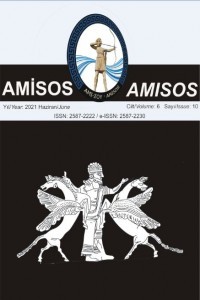NAHÇIVAN TEPE YERLEŞMESİNDE ARKEOLOJİK ARAŞTIRMALAR
Kalkolittik Çağda Güney Kafkasya’nın Mezopotamya dahil Yakın Doğu ile ilişkileri uzun yıllardır ki, araştırmacıların dikkatini çekmektedir. Birçok bilim insanları, aralarında R.M. Munçayev, O.H. Həbibullayev, İ.H. Nərimanov, T.D. Axundov ve diğerleri olmakla Yakın Doğu kültürlerinin Kafkaslar’a etkisinden bahsetmişler. Yakın Doğu ve Kafkasya arasında olan ilişkiler şimdiye dek tek-tek eserlerle temsil ediliyordu. Şimdi biz Yakın Doğu ve Güney Kafkasya’yı kapsayan tüm bir kültür karşısındayız. Bu kültür şimdiyedek Urmiya Havzası’nın güneyinden belli olan “Dalma Tepe Kültürü”dür. 2017 yılında Nahçıvan şehrinde yerleşen Nahçıvan Tepe yerleşmesinin araştırılması sırasında “Dalma Tepe Kültürü”nün tüm özellikleri ortaya çıkarılmıştır.Seramikler yerleşmenin stratigrafisine uygun olarak iki döneme ayrılabilirler. Genel olarak ele alındığında her iki dönemin seramikleri teknolojik ve bezeme açısından aynıdır. Onlar bant üsulu ile hamur laylarını bir-birinin yüzerine yerleştirmekle hazırlamıştır. Bazı kapların yüzeyi ince bir tabaka ile sıvanmıştır. Araştırmalar bu yöntemin bazen kapları bezemek, bazen ise onların rengini değiştirmek amacı ile kullanıldığını göstermektedir. Bu özellikle parmak baskısı ile bezenmiş seramiklere aittir. Kimi araştırıcılar parmak baskılı seramikleri etnolojik özelliklerle bağlantılı olduğunu söylemişlerdir.
ARCHAEOLOGICAL RESEARCHES IN THE SETTLEMENT OF NAKHCHIVAN TEPE
Existence of connections between the cultures of South Caucasus and those of the Middle East (including Mesopotamia) has drawn the attention of researchers for many years. Researchers such as R.M. Munchayev, O.A. Abibullayev, I.G. Narimanov, T.I. Akhundov and others spoke about the spread and distribution of cultures of from Middle East in South Caucasus. Although the existence of these connections was sometimes demonstrated by single finds, now however these connections are demonstrated by a complex of archaeological materials. One suchmonument is the settlement of Nakhchivan Tepe which is characterized by Dalma Tepe ceramics. We consider that is necessary to introduce to the scientific community the fact that this cultural assemblage has been revealed for the first time in the South Caucasus, and also to define its place among the other Caucasian cultures. The ceramics can be divided into two periods, based on the stratigraphy of the settlement. However it should be noted that the two groups coincide to a certain degree in terms of the technology of production and ornamentation. The ceramics were mainly produced by the coil method, and the application of two layers of potter's clay to each other. The surfaces of some vessels were covered with a thin layer of clay. The research demonstrates that this was done in some cases to change the color, and in others, for ornament purposes. It is also possible to discuss the products ornamented with finger impressions, which are sometimes are executed inaccurately and mixed together. The study demonstrates that the finger impressions remained after being stuck in the thin upper clay layer. We think that some researchers were right to connect Dalma Tepe ceramics with these ethnographic features. The study of bones of animals from this settlement has shown that the residents were generally were engaged in cattle and small cattle breeding. Hunting took an the insignificant place in the economy. The pottery of the settlement of Nakhchivan Tepe can be dated the first half of the V millennium BC. The analysis of coal from the lower horizon has shown 4945 BC. Thus it can be concluded that the area of formation and distribution of Dalma Tepe culture included Nakhchivan's territories. Undoubtedly, subsequent studies will clarify some questions of the nature of the mutual ties between the tribes of the basin of Urmia and Nakhchivan. We think that the issues related to the birthplace of Dalma Tepe culture will also be clarified.
___
- R.M. Munchayev (Мунчаев, Амиров, 2009, c. 41-52)
- O.A. Abibullayev (Абибуллаев, 1982, c. 72)
- I.G. Narimanov (Нариманов, 1985,c. 271-277
- Нариманов, 2003, c. 32)
- T.I. Akhundov (Achundov, 2007, p. 95-122)
